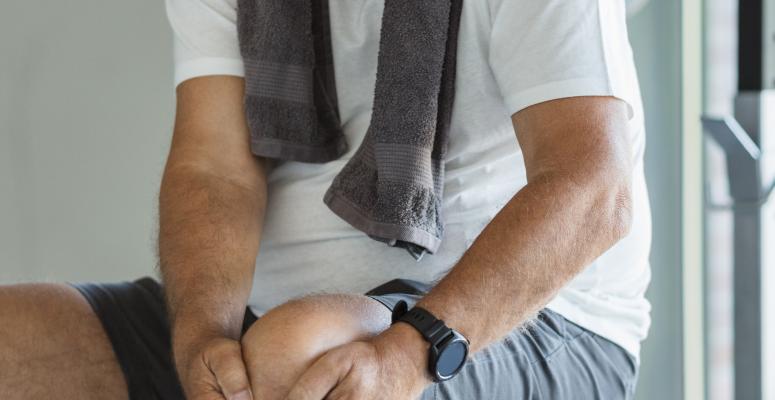
We put our knees through a lot on a daily basis, from standing up after sitting for an extended period of time to strenuous physical exercise during a workout. And all of that strain can put excessive stress on the ligaments that keep your knee muscles in place, such as the medial collateral ligament (MCL).
Your medial collateral ligament plays an integral role in the overall quality and mobility of the knee. That’s why proper MCL exercises are important for alleviating knee pain, especially after the MCL has been damaged due to an injury. We’re here to teach you about MCL exercises that will help to alleviate the pain so that your knee is ready to take on your daily routines.
Read on to learn about the basics of MCL injuries, how physical therapy can treat the pain and several exercises that can help.
The basics of MCL injuries
The medial collateral ligament, or the MCL, is the band of tissue that keeps your shinbone (tibia) in place. It’s located along the inner edge of the knee and helps connect your thighbone to your shin.
An MCL injury usually refers to a sprain or tear that could be caused by a variety of circumstances, including:
- Playing sports.
- Blunt trauma, such as a car accident or fall.
- Gradual wear and tear, such as consistent heavy lifting.
Symptoms of an MCL injury include:
- Pain along your knee’s inner edge.
- Swelling.
- Popping noises.
- Locking during motion.
- Stiffness.
- Tenderness.
How physical therapy can treat MCL injuries
If you’ve sustained an MCL injury, physical therapy should be one of the first treatment options that you explore. Not only can it help alleviate the pain, but it can also boost your knee’s overall quality by increasing its strength, flexibility and range of motion to reduce the risk of future injury.
There are a few different ways that physical therapy can treat the pain from an MCL injury. Your physical therapist will create a customized plan based on the cause and severity of the injury as well as your medical history and capabilities.
Manual therapy is often used for knee pain and injuries. These are hands-on techniques where the therapist utilizes their hands to loosen up soft tissue and mobilize the joints to decrease pain and increase range of motion. Your therapist may also recommend dry needling, which involves inserting the skin directly into the muscles, causing them to contract and release tension.
One of the best ways that physical therapy can help MCL injuries is through targeted exercises, several of which you’ll learn about in the next section. It’s important that your MCL injury is given time to rest before doing strengthening and stretching exercises to ensure that you don’t aggravate the sprain or tear.
4 MCL exercises that alleviate pain
When you feel knee pain that stems from an MCL injury, a physical therapist can walk you through exercises that will alleviate the ache and strengthen the affected muscles. The goal is to help you along the healing process and restore your knee’s mobility.
Some exercises may require additional equipment, such as a resistance band. Your therapist will instruct you on how many times to repeat each exercise.
Here are four MCL exercises to alleviate pain and strengthen knee muscles:
- Isometric quads contractions — Lie down with your uninjured leg flat on the floor and the injured knee resting on top of a type of cushion, such as a rolled-up towel. Contract the quad muscles on your injured leg and hold that contraction for 10 seconds. Repeat as directed by the physical therapist.
- Calf raises — Stand with your feet shoulder width apart, either on the floor or with your heels hanging off a step platform. Lift your heels as high as possible and slowly lower them back down. Repeat as directed by the physical therapist. Start with raising both heels, but you can move to one at a time as your injury continues to heal.
- Heel slides — Lie on your back and wrap a towel or resistance band around the heel of your foot on the affected leg. Slowly use the band to pull your heel up toward your buttocks. Hold it for as many seconds as directed by the physical therapist before moving your heel back down to rest.
- Hip extension — Wrap one end of a resistance band around a sturdy object, such as a table leg, and put the other around the ankle of your injured leg while standing. Bring your leg behind you so that the band becomes taut and then move it back to the starting position. Repeat as directed by the physical therapist.
Alliance PTP can connect you with physical therapy for an MCL injury
If you’re unsure about the proper way to do MCL exercises, you should reach out to us. At Alliance Physical Therapy Partners, we can help connect you with a physical therapy practice to treat your MCL injury and help you learn safe and effective MCL exercises.
If you’re not a fan of in-person PT sessions, or you’re not close to an Alliance PTP partner, you can receive effective and affordable virtual physical therapy through our Agile Virtual Physical Therapy platform.
Come find help for your injury or chronic condition today!
Get Help at a Location Near You
